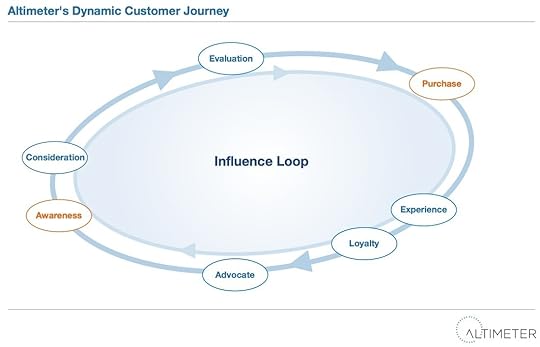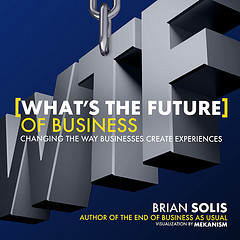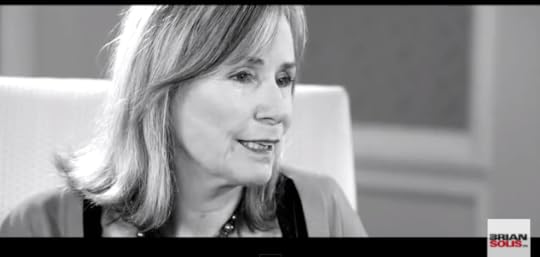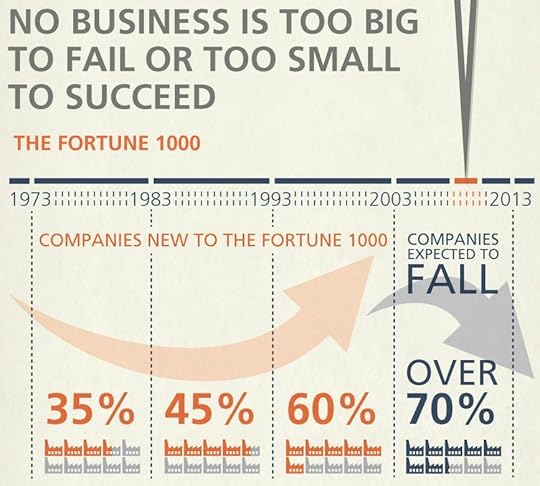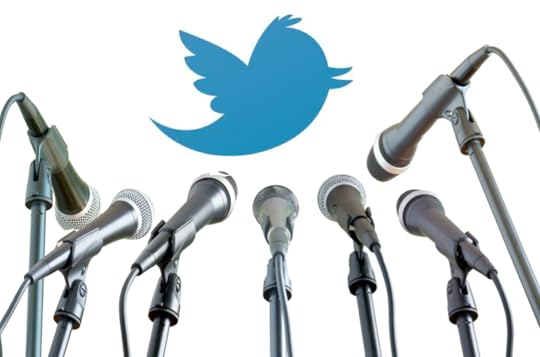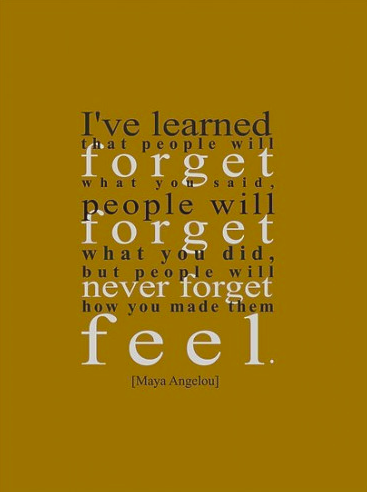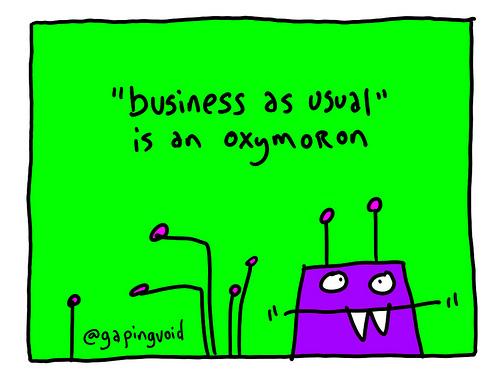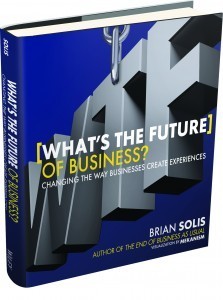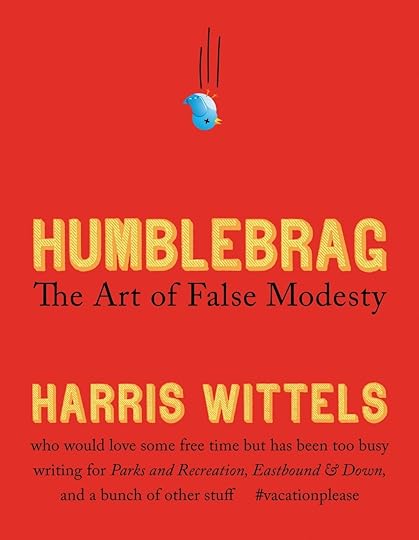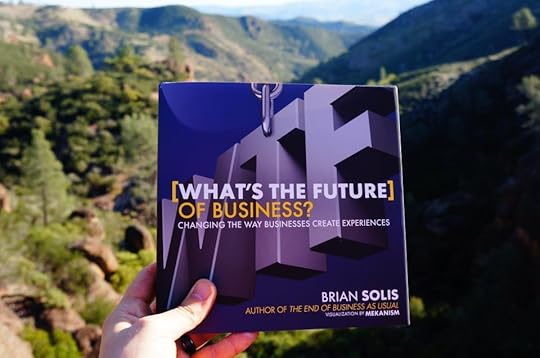Brian Solis's Blog, page 120
April 16, 2013
The Dim Light at the End of the Funnel
Over the years, businesses have developed sales, marketing and service strategies around the funnel. Awareness, interest, desire, action, to this day, describes the likely steps a customer may take in making a decision. Over the years, it was assumed that the liner path would also continue through a transaction to a state of loyalty and ultimately advocacy. The process of customer engagement to this day is designed to shepherd people along this delicate path. For at any moment, consumer attention, interest, and resulting action could fall astray without superintendence.
I call this the “Cluster Funnel” and it’s meant to demonstrate how a customer lifecycle when viewed in aggregate is broken.
Without awareness there can be no consideration. Hence, businesses today invest to varying degrees and effectiveness in marketing, advertising, and communications strategies. To earn customer attention isn’t a switch that toggles on and off, it is a state of perpetual engagement. The blaring noise that customers continually experience has forced them to adapt. Second nature acts as a defense mechanism to tune out the constant barrage of marketing messages and clever campaigns. Awareness at the top of the funnel is elusive but never more important.
The Cluster Funnel from What’s the Future of Business
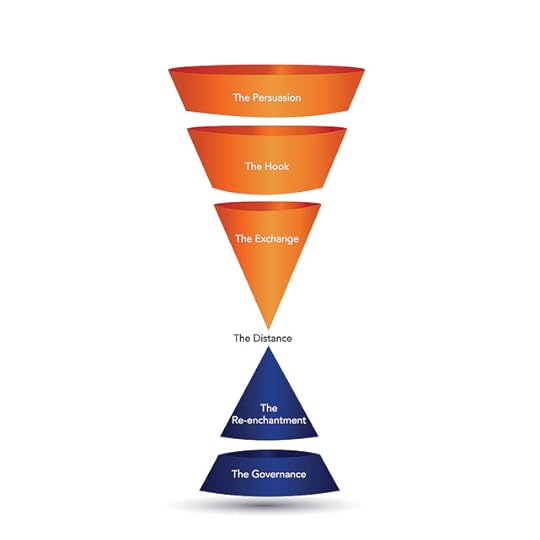
For the sake of this discussion, let’s assume that everyone understands the value of the funnel (or at least the idea of it) to attract customers and invest in long-term relationships. But what if businesses were investing their time and resources in the wrong places? What if where we think we can impress upon customers or get them to notice us is not at all where their attention is actually focused?
These are important and timely questions to answer as they will reveal a new journey to embark upon. The truth is that what we know and what we need to know are in fact separated by an unfolding reality that requires immediate intervention.
Your market has already been disrupted. Through an unforgiving series of technology revolutions paired with an era of individual empowerment, your customers are not only more informed, their expectations have matured. The “C” change in consumerism has ushered in a genre of connected consumers. As a result, your customers are learning about you or your competitors differently. How they make decisions does not at all follow a linear path. How they are influenced and in turn influence others is profound in its reach and effect. What was once simplistic, or overly simplistic depending on your point of view, representation of a fluted customer journey is in fact much more dynamic and connected.
Engagement is as much art as it is science. But to better understand the behavior of your connected customers or as I refer to them “Generation C,” takes practice of the social sciences from digital anthropology and psychology to sociology and ethnography. Understanding behavior exposes patterns in consumer activity that in of itself reveals new touch points. Appreciating how customers form and make decisions and why inspires empathy and creativity. This research will specifically point to what Altimeter Group refers to as the Dynamic Customer Journey. What you’ll learn following your research is everything. Most notably, your business will now earn clarity in how and where to focus efforts on shaping decisions and experiences pre-, during, and post commerce. Additionally, you’ll learn the specific factors, people, technology, communities, and resources that affect every stage of your customer’s journey. The results will contribute to a far more accurate point of view that tailors marketing, sales, service, and loyalty strategies to be more effective and engaging. But it won’t stop there.
Inspired by McKinsey’s work and my own research during the writing of The End of Business as Usual, we re-imagined the traditional funnel into a constant and very public elliptical path that often repeats itself.
1. Awareness
2. Consideration
3. Evaluation
4. Purchase
5. Experience
6. Loyalty
7. Advocacy
The stages of the Dynamic Customer Journey are familiar as they reflect similar methodologies in the traditional funnel. However each step is unique in the contributing factors for how consumers discover, analyze, choose, and share. The screens they use to search and purchase, the people who influence them, the content that informs them, the social networks they rely upon, the collective experiences of others, and the real-time conversations that shape impressions, each introduce guidance, doubt, and validation that works for or against your right now. The most important revelation in the DCJ is how every stage feeds into a discoverable online repository of shared experiences that influence all those who embark upon a similar journey. Without positive influence there is no hope for preference. And, without positive experiences there can be no chance for loyalty or advocacy.
It is only by traveling in the digital footsteps of your customers that uncovers a new landscape for engagement and also a new reality for your business. Embracing your connected customers will help them embrace you in return. At a minimum, the gifts you receive by embarking on this journey and investing in engagement, education, and meaningful experiences are empathy, relevance, and ultimately reciprocity…all of which is measurable by traditional business metrics.
The story continues…
Connect with me: Twitter | LinkedIn | Facebook | Google+ |Youtube
Photo Credit:
This post is based on a piece I wrote for AT&T’s Networking Exchange, which is a preview of content in WTF

April 11, 2013
Be on your best behavior! Behavioral expert Kare Anderson on how to design idyllic experiences
“If we feel instinctively liked by someone else then we tend to tend to project unto them the qualities we like in other people…and that’s priceless.”
Those are the wise words of Kare Anderson, expert on the art and science of understanding and perfecting behavioral cues. As she shares, emotion precedes rational thought. In this episode of Revolution, we learn about the importance understanding what we do and don’t appreciate in others to improve how we connect and communicate. If you’re aware of what of these nuances, you can bring out the best in other people including yourself. Kare’s work doesn’t just focus on real world or even interactive engagement. She believes that the same techniques can be applied to improve design, user experience, and ultimately relationships.
Subscribe here.
Shot on location at The Four Seasons Hotel, San Francisco

April 9, 2013
The 9 Laws of Affinity in an Era of Digital Darwinism
We are indeed witnessing what can be best described as the end of business as usual. With the closure or dwindling performance of businesses once regarded as too big to fail or with the rise of every new Occupy-like movement around the world, we are reminded of the grand chasm that exists between consumer values and the values of today’s businesses. What is becoming painfully obvious is that people everywhere are calling for change and they’re taking to the streets and also their smartphones, tablets, and popular social networks to demand attention.
The reality is that people are much more connected than ever before and their mission is to not only mind the gap, but narrow it. Technology is a game changer and through the devices and networks that connect consumers, it is also the critical path for businesses to earn and re-earn relevance and trust. Without evaluation or introspection, businesses however may well face digital Darwinism, the evolution of consumer behavior when society and technology evolve faster than the ability to adapt.
On April 21st 2011, Forbes ran a sobering article that carried an ominous prediction, “If the current trend continues, over 70% of Fortune 1000 companies will turnover from 2003 to 2013.” Change is in the air and what the relationships between customers, stakeholders and businesses look like from here forward is uncertain. But, it is in the attempts at defining meaningful relationships where businesses will find guidance moving forward.
Think about it for a moment. Today’s biggest trends- the mobile web, social media, gamification, real-time- are changing the consumer landscape. Everyday people are empowered and influential. What we must realize however is that consumers are learning how to improve their online experiences and as a result, it is forcing individuals to think and re-think about the people, organizations, and information they choose to connect with. You are either part of the equation or you’re not.
While this is the end of business as usual, it is also the beginning of a new era of relevance. Businesses now have an opportunity to become relevant in new channels and networks by earning attention and forming meaningful alliances. To do that takes far more than gimmicks, creative marketing, contests and viral videos. It takes the consistent delivery of value based on ongoing listening and meaningful engagement.
The reality is that how this new breed of connected consumers discovers, shares, and communicates differently than their traditional consumer counterparts. To connect with them requires study to identify challenges, themes, POVs, and interests. To adapt, organizations need to examine the impact of technology on consumer behavior and understand its affect on how connected consumers make decisions and influence the decisions of their peers.
People have uninhibited access now to social platforms, channels and tools to express themselves at will. And, people too have an offline and online voice that when used individually and collectively, they can reach the masses and organize movements that cause everything else to pause for reflection. Yet, even though we know this, businesses are still struggling to understand the real impact of connected consumerism. Many still wonder if this is all just a fad.
At the heart of this consumer revolution is the need for people to be heard and for them to see that action is taken on their behalf. Technology serves as the glue that bring like-minded people together. This is why relationships are now more important than ever. Even though people are connecting in social networks, just creating a presence on Facebook or Twitter isn’t enough to show that you’re listening. Nor does it convey empathy or a new vision. Hosting conversations or getting people to follow you on Twitter or Like you on Facebook is one thing. But, to connect and foster real relationships, organizations must learn how to dedicate resources to listen, learn and adapt the processes, systems, experiences and prevailing culture that will entice and nurture consumer engagement.
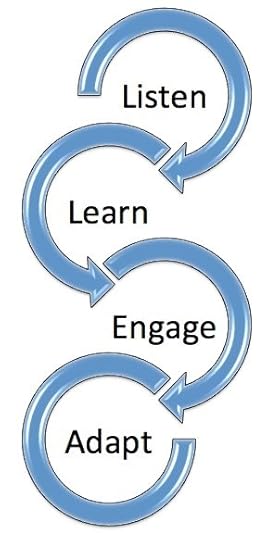
The reality is that we live and compete in a perpetual era of Digital Darwinism. But, nothing today is too big to fail nor too small to succeed as long as relevance and value are in scope. Even though technology may seemingly play a role in working against your business, it can also work for you. The good news is that you have a role in defining where all of this goes.
Everything begins with learning how and where to listen. I’m not referring to the type of listening that tracks mentions of your company or competition. I mean discover how to deliver value based on what’s said and unsaid. It is attention and value that will attract connected consumers and ultimately earn their affinity. Additionally, what you learn, must permeate the organization to help it adapt to new opportunities. To survive digital Darwinism, it’s not about the survival of the fittest, it’s about the survival of the fitting. I refer to this as the Laws of Attraction and Affinity in Chapter 11 of The End of Business as Usual and have included an excerpt of the list below.
To attract consumers and earn affinity, business must follow the Laws of Attraction and Affinity:
1. Identify where the attention of the connected consumer is focused.
2. Define a higher purpose along with genuine intentions. Also, establish a sense of value to attract connected consumers, giving them something to align with.
3. Establish an identity and a presence worthy of affiliation. Give people something to believe in and something exciting to be a part of.
4. Design the presence and engagement strategies and all that fuels interaction to be beneficial and shareable—this is, after all, about shared experiences.
5. Based on the presence of each D2C community, localize the value, content, storefront, and engagement program to match the culture and activity within.
6. This isn’t a power switch; stay consistent and dedicated through meaningful interaction.
7. Remain true to the original mission and intention. Do not be swayed on the basis of short-term temptations.
8. Recognize and reward community participants—reciprocity is a strong pillar of community and relationships.
9. The adaptive business will listen, learn, and change based on the needs of the connected, and all other consumers to stay relevant, indispensable, and valuable.
The story continues…
Connect with me: Twitter | LinkedIn | Facebook | Google+ |Youtube

April 4, 2013
Dr. Shaquille O’Neal Dunks on Investing, Geekery, and Social Media

One of the highlights of SXSW Interactive this year was Dr. Shaquille O’Neal (did you know he had a doctorate degree?). He joined me on stage at the Long Center for Performing Arts to a theater packed with adoring fans. Before we took the stage, we spent some time to shoot a special episode of Revolution.
Not only is Dr. Shaq an NBA champion, an Olympic gold medalist, a 15 time All Star, 6th on the all time scoring list, and an all-around icon, he’s an active investor and self-described geek. His portfolio includes Google (pre-IPO), Five Guys, Vitamin Water, Muscle Milk and a whole slew of traditional businesses and tech startups. While at SXSW, we walked through the Startup Village as part of a “Pitch Shaq” initiative hosted by real-time video network Tout. At the end of our session, Shaq announced that he would take official meetings with two lucky startups, Speakerfy and Beam.
On the technology front, Shaq is always looking for the next big thing. He bypassed traditional media and announced his retirement on Tout, a platform that at the time had only been live for six weeks. Shaq was early to embrace Twitter where he still engages with his now 7 million fans. In fact, Jack Dorsey was once asked who he thought the ideal Twitter user was and his response was Shaq. Why? Because he’s engaged, it’s him, and he believes in community. His mantra for social media is 60% to make you laugh, 30% to inspire you and 10% to let you know about this product.
Take a few minutes to watch this enchanting interview. I think you’ll agree, Shaq is not only an investor, geek, and super star, he’s also a wonderful human being.
Subscribe here.

April 1, 2013
Q&A: Why the Future of Business is Shared Experiences
Jeff Ashcroft (@JeffAshcroft) along with @TheSocialCMO host the popular #MMchat (Marketer Monday) every week at 8 p.m. eastern on Twitter. It’s a rapid fire exchange not only between the organizer and the guest but also everyone following along #MMchat. It certainly makes for exciting dialog in real-time and also later when the full transcript is published. I recently joined them to discuss the future of business and why now is the time to become the hero in your hero’s journey. I’ve recreated our exchange (each in 140 characters or less) for you here…
Question 1: Why are experiences more important today than ever before?
A1: .@TheSocialCMO Thank you so much for having me on again. This is always one of the most invigorating conversations I can be part of.
A2: Experiences are something we feel and we share what we feel. We share what moves us
A3: When people ask questions for advice or direction, shared experiences are the result. In social, they’re more important than ever
A4: Customers are sharing experiences about your business now. Why leave them to chance. Define them at every step!
Question 2: In the book you say experiences are even more important than products! Bold statement can you share your reasoning on this?
A1: Experiences are more important than products. Products are manifestations of the experience you want people to have+share
A2: Products are just part of the experience ecosystem. You have to first define the experience you want people to have
A3: Products play a role in the manifestation of the experience they will have and share. You must define the moments of truth
Questions 3: Seems like everyone is talking about disruption. You’re saying disruption is more than just social media, can you elaborate?
A1: Disruption is something that occurs naturally. It’s “creative destruction” if you will. But it’s accelerating beyond social
A2: Social is just one part of disruption. I call it “The Wheel of Disruption” and it includes big data, mobile, real-time, etc.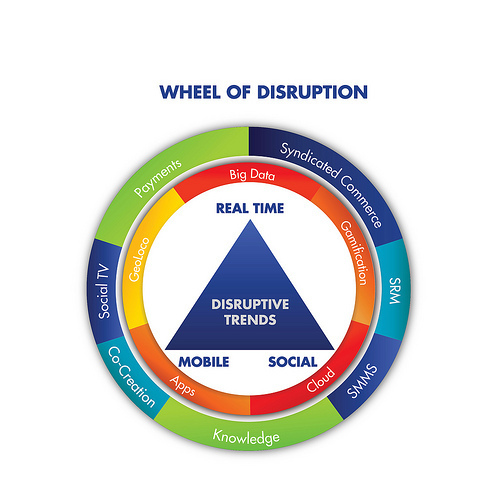
A3: I suggest that change agents look at the experiential aspects + new touchpoints in the 4 moments of truth. That’s disruption
Question 4: Need for more emphasis on experience is clear in the book. How is user experience now starting to influence business decisions?
A1: Shared experiences form an influence loop that is connected to each moment of truth. It’s what people find that guides them
A2: It takes more than google now. people are talking and connecting. experiences are shared in tweets, posts, videos + reviews
A3: You’ve optimized search, your website, your mobile app, but you haven’t optimized for shared experiences
A4: Shared experiences affect customer impressions and next steps in each moment of truth. Shift from impressions 2 expressions
Question 5: In WTF? There seems to be underlying story recounting the hero’s journey. Can you share your thoughts with us on this journey?
A1: A VERY GOOD QUESTION!
A2: Joseph Campbell’s Hero with a 1000 Faces has influenced so many, including Hollywood…Star Wars, The Matrix.
A3: The Hero’s Journey explores mythical journeys such as those of jesus and buddha and the common experiences they shared
A4: I revisit the Hero’s Journey from the standpoint of your customer. What is their journey? What is their experience?
A5: Your customer is your hero…you define their journey
A6: In the end however, as the reader, you are also becoming the change agent. Therefore you are also “the hero”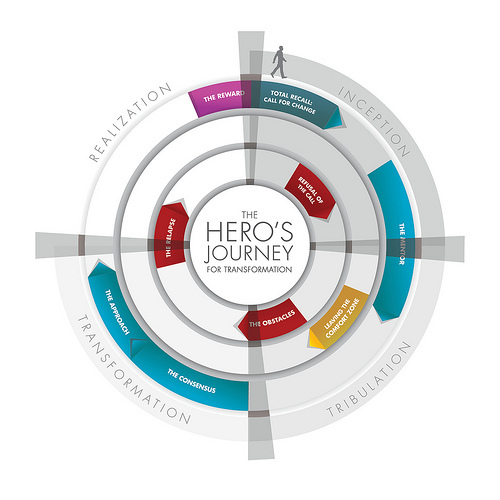
A7: I re-imagined the Hero’s Journey for you to outline where you’ll meet challenges and how to break through them
Question 6: Brian, love design of the book. I understand in this case it wasn’t your typical publisher process, how was it different?
A1: Number 6 is great too!
A2: 2 show the importance of experiences, you have to create an experience. Whats the Future of Business is an experiential book
A3: The publisher gave turned over creative control. I worked with Mekanism and @gapingvoid to create a true “social object”
A4: The book is square, think coffee table format, 4 color, full of visuals, and its designed to be an analog (mobile) app!
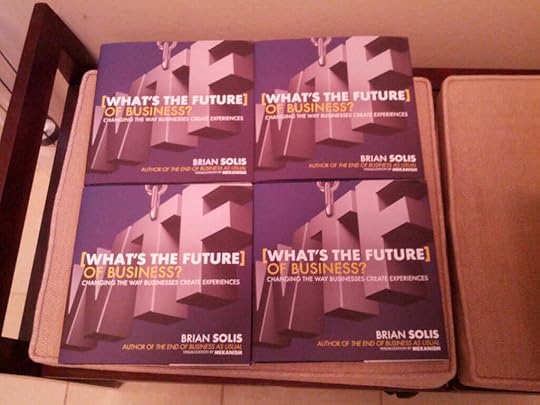
Source: Jeremiah Owyang
A5: @gapingvoid provided an original piece of artwork for each chapter based on what he took away after reading it.
A6: What’s the Future of Business is as helpful and inspiring as it is beautiful… #promise
A7: Remember, this is your time… #AdaptorDie
A8: The future is yours to define… #InnovateorDie
A9: Thank you everyone. You always get my mind racing with possibilities!
FIN: Thanks for joining us! Your participation & feedback was GREAT! An extra SPECIAL thanks to @BrianSolis for joining us! #MMchat
The full transcript including all responses, questions, and answers is here.
WTF is now available!
Connect with me: Twitter | LinkedIn | Facebook | Google+ |Youtube

March 28, 2013
Angel Investor and Entourage Actor Adrian Grenier Starts Music Incubator
When he’s not starring in movies and television, Adrian Genier is a serial entrepreneur. Most recognized for his role as Vincent Chase in HBO’s Entourage, and also the upcoming movie, Grenier has co-founded or invested in several companies including SHFT, Fansnaps, and Churchkey Can Co. Now he’s at it again but this time, he’s changing his tune.
While at SXSW in Austin, I spent some time with Grenier to talk about his new music incubator, The WRECKROOM. The idea is not unlike tech incubators planting seeds of innovation around the world. WRECKROOM is a collaborative space built in Grenier’s home in Brooklyn. Artists are encouraged to come by, write and collaborate. And for those artists that get the attention of the team, recording and distribution could be a possibility.
On the website, you’ll see and hear some of the WRECKROOM’s current portfolio including Caldwell, a band he formed with Emily Caldwell. While on set, we were also introduced to another WRECKROOM project, The Skins, a band that I also fell in love with during their live performance that followed this interview. Let’s hear from Adrian now on this latest episode of Revolution.
Subscribe here.

March 26, 2013
Think Like a Startup: Growth Hacking Introduces New Marketing Hacks to Businesses
Do more with less! Sound familiar? This is a statement I hear in almost every strategy and planning meeting I attend on behalf of enterprise and startup clients alike. The idea of course is to accomplish great feats, beyond the output or achievements of years gone by, without the previous resources exploited over time.
Several years ago, I adopted a way of thinking to help me realize that how things are done today isn’t indicative of how they could be. As such, I’ve adopted a mantra of “constraint forces creativity.” Constraint isn’t defined by cash flow or edicts, but instead the restriction of the boundaries that confine us to customary processes and views.
Yes, there are times when you can, when you should do more with less. But doing more with less isn’t a mantra in of itself. It’s a representative of a form of administration that attempts to boost productivity while operationalizing processes and optimizing efficiencies. Yes, that was corporate speak. It’s nonetheless true however.
This is how organizations compete today without necessarily thinking about how these activities position them in the future.
Innovation and risk taking often carry too much of a cost to bear for some companies. It’s more than finances however. Exploring new solutions also presents a significant opportunity cost that may in fact signify doing more with more rather than doing more with less. This presents a catch 22 of sorts. If you effectively “do more with less,” you may actually deliver less with less. If you discover ways to creatively excel, the pervasive culture of optimizing and operationalizing business practices may not truly appreciate the extent of your (and your team’s) sacrifices. New ideas often die on the vine.
The Hacker Way
“The Hacker Way” is the ideology that Mark Zuckerberg has long employed at Facebook. It’s also the name of the road that leads to the company’s sprawling campus in Menlo Park California.
To succeed in business today, there’s indeed a hack for that…
Everything begins with a shift in perspective and culture. What if the entire organization or at least those with driving impact where empowered? Sometimes it takes learning from the lean and mean world of startups to get larger organizations back on track.
Startups are the new darlings of their industry. Twitter, Foursquare, Instagram, Pinterest, Uber, AirBnB, these are the forces that are disrupting age-old business models while creating entirely new markets. In the world of startups, unlike larger organizations, employees not only wear multiple hats, they’re empowered to excel on each front to help the organization gain momentum and ultimately grow. This is classic intraprenuerialism. This approach takes the elements that represent the defining pillars of entrepreneurialism and attempts to celebrate them within a larger ecosystem.
Intrapreneurs are the New Entrepreneurs
Intrapreneurs rethink and promote innovation in processes, product development, marketing, collaboration and anywhere and everywhere it’s needed or possible.
In the startup community, one of the most talked about trends in intrapreneurialism is the role of growth hacking. To be a growth hacker is someone who is specifically tasked to do more with less. The difference here is that growth hackers take it upon themselves to do more with less as they hack the way things are done to find a potent way of obtaining goals.
What is a growth hacker?
Growth Hacking is the art and science of creating awareness, traction, adoption, and advocacy using unorthodox and surprising means. It’s quite literally a hack for traditional processes to accelerate business.
In 2010, Sean Ellis introduced us to the role of growth hacker in his post, “Find a Growth Hacker for Your Startup.”
In his post Ellis recognizes the difference between Growth Hacking and traditional marketing and business development, “…the problem is that most startups try to hire for skills and experience that are irrelevant, while failing to focus on the essential few skills. Typical job descriptions are often laden with generic but seemingly necessary requirements like an ability to establish a strategic marketing plan to achieve corporate objectives, build and manage the marketing team, manage outside vendors, etc.”
If you’re unaware of Quora, spend some time there. Quora is the defacto Q&A hub for all things disruptive and bleeding edge when it comes to technology, trends and the people behind them. On the topic of Growth Hacking and what it is and isn’t, the top ranked answer comes from Andy Johns, “It’s the idea that an entrepreneur can take a clever or non-traditional approach to increasing the growth rate/adoption of his or her product by ‘hacking’ something together specifically for growth purposes. What people call ‘hacking’ today will become common sense to most in the tech world in the future because people are waking up to the fact that growth doesn’t simply come from having a good product.”
Of course when you hear the word hacker, you probably think of breaking into networks or hijacking computers to illegally access files and information. Hacking is though a method of bypassing traditional tasks to obtain a goal.
To compete for the future and ultimately relevance, leading technologists believe that the future of marketing comes down to technologists. Growth Hacking sounds intriguing, but at its root, it represents homage to programming and respect for the culture of online, social and mobile communities in order to influence different behavior.
In 2012, Andrew Chen, an entrepreneur and blogger based in Silicon Valley described the skillset that serves as the undercurrent of growth hacking in his noteworthy article, “Growth Hacker is the New VP of Marketing.”
This is a defining piece as it outlines the importance, the responsibilities and the potential outcomes when growth hackers assume the role of marketing, “This isn’t just a single role – the entire marketing team is being disrupted. Rather than a VP of Marketing with a bunch of non-technical marketers reporting to them, instead growth hackers are engineers leading teams of engineers.
Growth Hacking is intrapreneurialism enacted.
Chen continues, “Before this era, the discipline of marketing relied on the only communication channels that could reach 10s of millions of people – newspaper, TV, conferences, and channels like retail stores. To talk to these communication channels, you used people – advertising agencies, PR, keynote speeches, and business development. Today, the traditional communication channels are fragmented and passé. The fastest way to spread your product is by distributing it on a platform using APIs, not MBAs. Business development is now API-centric, not people-centric.”
People are the 5th P of Marketing and the Source of Growth in Growth Hacking
While I take exception to the last line being “API-centric” and not “people centric,” Chen’s bigger argument is that it takes technologists to hack technology to reach desired audiences to drive desirable clicks, conversions and outcomes. He’s right. But, he’s wrong about people. People represent the 5tH P of Marketing and it’s through empathy in understanding real world challenges that opens the doors to new opportunities. Said another way, people and their aspirations and frustrations should inspire you.
The key is programming journeys that deliver coveted experiences. And that’s what this is really about. Growth Hacking finds new ways of creating awareness and constructively handholding people into a dynamic customer journey that is thoughtful, productive, and meaningful…on any platform.
To succeed in business and continually compete for the future takes a culture of intrapreneurialism to spark innovation within. Remember it’s less about doing more with less and absolutely about finding or creating solutions when resources or opportunities are either constrained or inhibited by convention. Growth hacking isn’t just about finding new means for the sake of hacking it, it’s about discovering a means to an end when the various forms of other means produce mediocre or lackluster results.
Why settle when new frontiers have yet to be discovered?
WTF is now available!
Originally appeared in AT&T’s Network Exchange
Image Credit: Shutterstock

March 22, 2013
How I Faked Celebrity Tweets in Support for My New Book and Why You Should Care #WTF
I just can’t believe it. On Friday afternoon, my Twitter stream was overflowing with Tweets and Retweets of what could only be best described as an outpouring or gushing of love and support for my new book by some of the world’s most recognized celebrities in the world. Seriously…WTF!?
See for yourself…
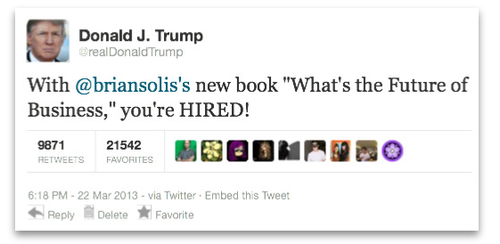
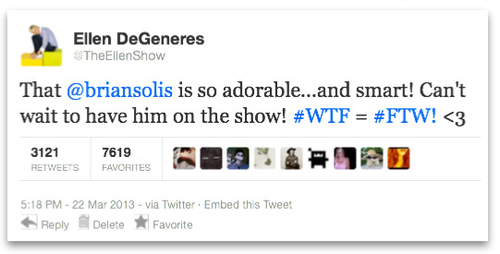
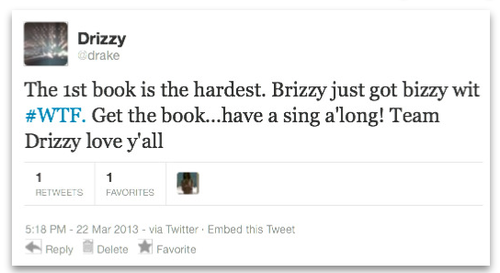

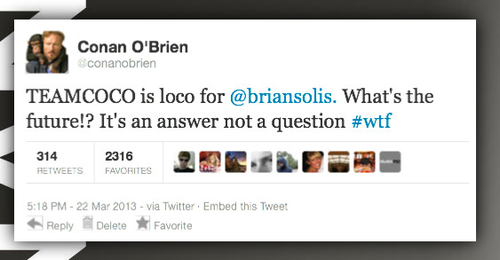
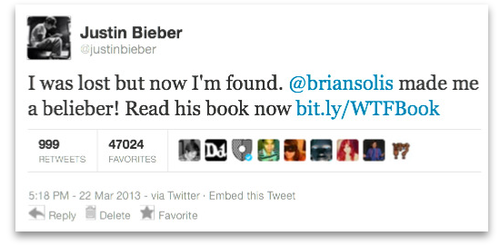
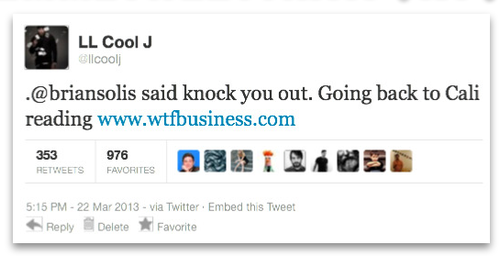
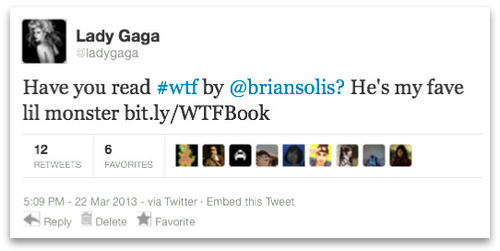
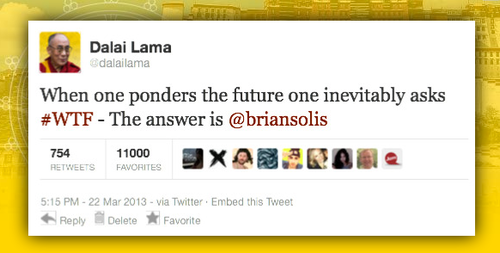
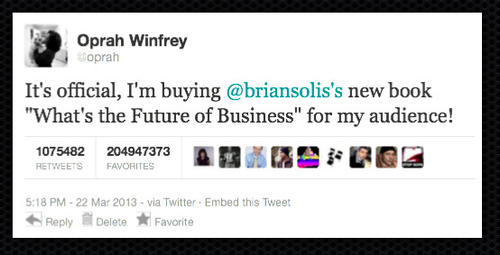
I’m sure by now you’ve figured out that this is a spoof…these Tweets are not real and that’s the point. Allow me to explain…
These tweets were generated using a fun little service LemmeTweetThatForYou. Although the site is about a year old, I learned about LTTFY upon reading a rather serious article today on Poynter that points to the darker side of the service, “…site raises concerns for journalists.”
While it’s all fun and games at first, there are incredible implications that can arise for those who do not take proper measures to check facts. And in a real-time world, getting to the truth is often an important task that goes undone. There’s an innate element of trust in social streams…either that or inherent gullibility or laziness. People tend to believe what they see and react accordingly. There are people who are already ReTweeting this post without getting this far to see it’s in fact a farce.
That should be a bit scary for journalists and anyone else concerned about potential hoaxes. Of course, it would be pretty easy to debunk one of these fake tweets if you just visit the person’s actual Twitter profile to see if the tweet really exists.
What’s the big deal you might ask?
Not only can you create fake Tweets from celebrity accounts, you can essentially design a counterfeit Tweet to come from any account you like. @BryanKramer demonstrates this in a comment below.
Everything you see in the screenshot above is customizable. From username to date and time to the number of ReTweets and Favorites, you can put Tweets into anyone’s mouth or fingertips in real-time.
As Jeff Sonderman wisely cautions readers, “But what if it’s passed off as screenshot evidence of an allegedly deleted tweet? Much tougher to disprove. Proceed with caution.”
Indeed. Sometimes in real-time, we need to take a moment to make sure that what we see is right…right now. Verify. Fact check. Take a breath before reacting. At the same time, it’s okay to have fun too! As I’ve always said, with social media comes great responsibility. But what doesn’t change, even in the face of technology, is ethics. You are what you Tweet.
#ITweetThereforeIAm
#ILieThereforeIAm

March 21, 2013
San Francisco Mayor Ed Lee Adopts Startup Culture in Government
Welcome to the season 4 premier of Revolution! Believe it or not, this is the fourth season of bring you some of the best minds exploring the revolution and evolution in tech, business, and culture. In this premier episode, I’m more than proud to host San Francisco Mayor Ed Lee on the show. Together we explore how governments can adapt and improve services by embracing startups and the culture that helps them accelerate and excel.
As you’ll hear, Mayor Ed Lee believes that the answer begins with recognizing that the gap that separates how things are done and how they need to be done can decrease with technology. One of the first orders of business was to form a tech chamber of commerce, SF CITI (Citizens Initiative for Technology and Innovation) to leverage the collective power of the tech sector as a force for civic action in San Francisco. Companies include AT&T, Salesforce.com, Jawbone, Twitter, and Zynga.
Additionally, San Francisco partnered with Code for America to help re-examine the way the city delivers services to people who live in poverty. The goal is to create a database and network of hope.
Mayor Ed Lee’s work focuses on today and also 10-15 years down the road. His team and his partnership with entrepreneurs, non profits, local businesses and investors, and influencers is already expanding possibilities for how San Francisco can look over the years, improve relationships with and opportunities for citizens, and help businesses thrive…all through technology and the new perspective and capabilities that come along with it. As the Mayor believes, everything comes down to improving and leveraging civic engagement.
Subscribe here.

March 19, 2013
I’m proud to announce that my new book, What’s the Future of Business, is now available
It is with the utmost excitement that I finally announce the availability of What’s the Future of Business, Changing the way businesses create experiences (www.wtfbusiness.com). You can get it now at Amazon, B&N, iTunes. It’s also available for Nook and Kindle.
It’s been a long journey to this point. Following my last book, The End of Business as Usual, I set out to answer an important question, if this is the end of business as usual, then what‟s next and what do we do about it?
The book explores in a fun, visual and insight way how connected consumerism breaks down into Four Moments of Truth, the role of technology in decision-making, and how businesses need to create experiences that mean something in each stage and also spark engagement between consumers based on those experience.
What’s the Future of Business also takes readers on an uplifting “hero’s journey” to help them bring about change from the inside out. The end result demonstrates how experience design amplifies customer relationships, drives word of mouth, and fosters organic advocacy. The point is that experiences can often trump your product or service.
WTF is the Experience: Where Business Meets Design
With the new book, I also set out to try something new with the very traditional model of book publishing. My goal was to make the book an experience and as such, we took a creative approach to living up to the book‟s tagline, “changing the way businesses create experiences.” It‟s designed to be immersive…think of it as an analog app.
The design is striking and also features a neat slider that guides readers through each chapter. First, the book is printed in 4 color and is square in shape, similar to that of a coffee table book. It was designed in partnership Mekanism (the team behind the popular Pepsi/Beyonce ad during Super Bowl 2013. Every chapter also features original artwork based on key themes within each by renown artist Hugh MacLeod (@gapingvoid) of Social Object Factory.
See for yourself…
Preview The First Two Chapters for Free
#WTF
Image Credit: Steven Gadecki



